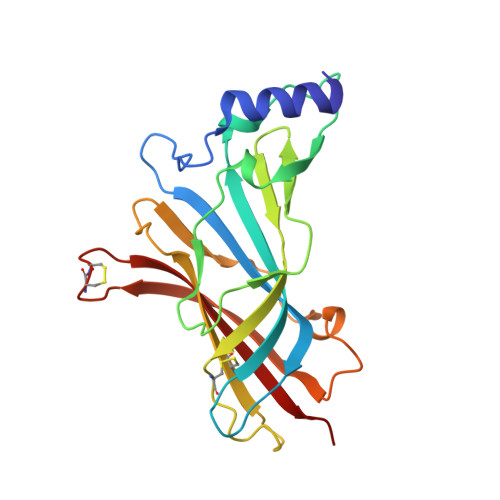Rigidity of loop 1 contributes to equipotency of globular and ribbon isomers of alpha-conotoxin AusIA.
Ho, T.N.T., Abraham, N., Lewis, R.J.(2021) Sci Rep 11: 21928-21928
- PubMed: 34753970
- DOI: https://doi.org/10.1038/s41598-021-01277-4
- Primary Citation of Related Structures:
7N0W, 7N0Y - PubMed Abstract:
α-Conotoxins are small disulfide-rich peptides targeting nicotinic acetylcholine receptors (nAChRs) characterised by a C I C II -X m -C III -X n -C IV framework that invariably adopt the native globular conformations which is typically most potent. α-Conotoxins are divided into several structural subgroups based on the number of residues within the two loops braced by the disulfide bonds (m/n), with the 4/7 and 4/3 subgroups dominating. AusIA is a relatively rare α5/5-conotoxin isolated from the venom of Conus australis. Surprisingly, the ribbon isomer displayed equipotency to the wild-type globular AusIA at human α7-containing nAChR. To understand the molecular basis for equipotency, we determined the co-crystal structures of both isomers at Lymnea stagnalis acetylcholine binding protein. The additional residue in the first loop of AusIA was found to be a critical determinant of equipotency, with 11-fold and 86-fold shifts in potency in favour of globular AusIA over ribbon AusIA observed following deletion of Ala4 or Arg5, respectively. This divergence in the potency between globular AusIA and ribbon AusIA was further enhanced upon truncation of the non-conserved Val at the C-termini. Conversely, equipotency could be replicated in LsIA and TxIA [A10L] following insertion of an Ala in the first loop. These findings provide a new understanding of the role the first loop in ribbon and globular α-conotoxins can play in directing α-conotoxin nAChR pharmacology.
Organizational Affiliation:
Institute for Molecular Bioscience, The University of Queensland, Brisbane, 4067, Australia.















